
NASA has released an astonishing new picture of Jupiter, showing a crescent Jupiter, along with its iconic Great Red Spot and planet’s megastorm.
Jupiter is the largest planet in our solar system and appears to astronomers as a deep red orb surrounded by layers of orange, pale yellow, and white. Jupiter’s Great Red Spot is actually a gigantic spinning storm – more than twice Earth’s size – in the atmosphere of the planet. The maximum speed of winds inside the storm sometimes reaches about 270 miles per hour.
According to NASA, the new image was created by Roman Tkachenko, a citizen scientist, using Juno Cam’s images captured on December 11, 2016 when the Juno spacecraft was performing its third close flyby of Jupiter.
Juno is a NASA space probe launched from Cape Canaveral on August 5, 2011, with an aim to study planet Jupiter. Juno was built by Lockheed Martin as part of NASA’s New Frontiers program to study Jupiter’s composition, magnetic field, gravity field, and polar magnetosphere. It is operated by NASA’s Jet Propulsion Laboratory. Juno entered a polar orbit of Jupiter on July 5, 2016. The mission life of Juno is 20 months, and during this period, Juno will try to find clues about the formation of Jupiter, the amount of water present within the deep atmosphere, mass distribution, its core composition, and its deep winds. After completion of the mission, the spacecraft will be deorbited into Jupiter’s atmosphere.
Juno is the second spacecraft, after Galileo, to orbit Jupiter. The nuclear powered Galileo spacecraft orbited around Jupiter from 1995 to 2003. Juno uses its solar arrays to get power to operate. Juno has three largest solar array wings ever deployed on a planetary probe, which generate power for Juno and also help in stabilize it.
In new image, a reddish long-lived storm known as Oval BA could be seen below the Great Red Spot. A series of other storms shaped like white ovals, sometimes referred as the ‘string of pearls’ are also visible.
According to scientists, Jupiter’s new images suggest a rare wave north of the planet’s equator. A unique filamentary feature in the core of the Great Red Spot has also been observed, which was never seen earlier. The new pictures also confirm that the Great Red Spot is shrinking and becoming more circular.
“Every time we look at Jupiter, we get tantalizing hints that something really exciting is going on,” said Amy Simon, a planetary scientist at NASA’s Goddard Space Flight Center in Greenbelt, Maryland.
“This time is no exception.”
Simon and her team have also created two global maps of Jupiter using the data gathered by Hubble’s high-performance Wide Field Camera 3.
